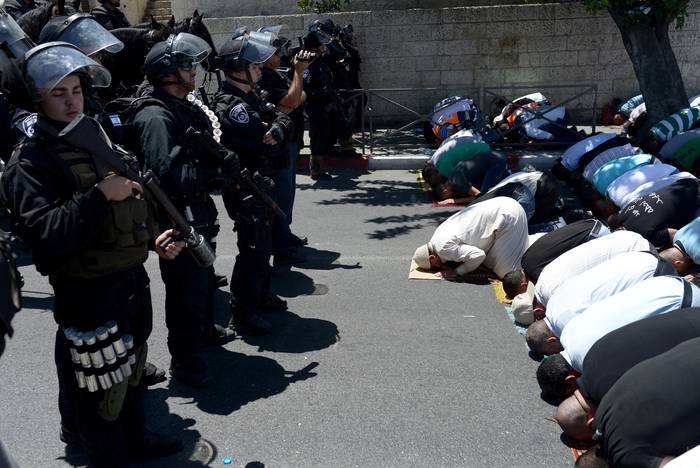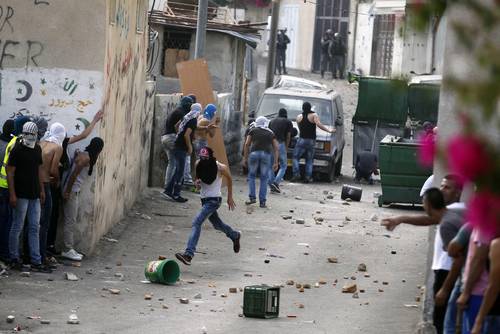
Introduction
Since long before the division of Palestine in 1948 into an Israeli state and a series of “occupied” and “administered” territories, Jerusalem has been the rallying point for Palestinians in search of a state in historic Palestine. Its cultural, religious and geographic centrality to the Palestinian nation, at home and in exile, has never been questioned.
Despite the ideological split and geographic prejudices that have plagued Palestinians over the decades, they have never differed on the centrality of Arab and Palestinian rights in the walled city or the dozens of surrounding villages and neighbourhoods, but with Gaza under long-term siege and isolation and the West Bank cities and towns divided by thousands of metres of barrier-walls, hundreds of settlements and endless permanent and flying military checkpoints, Palestinians in Jerusalem now stand alone in their struggle to remain in their city.
In the past, confrontations around the al-Aqsa Mosque compound have resulted in dozens of Palestinians dead and hundreds of wounded. Significant confrontations began in 1969, only two years after the Israeli occupation of the city. An Australian fundamentalist evangelical Christian burned down the pulpit of the al-Aqsa mosque in the hope of destroying the whole mosque in order to replace it with a Jewish temple.
In October 1990, Israeli troops killed 22 Palestinians protesting inside the compound. In 2000, the Israeli leader Ariel Sharon provocatively walked into the compound with a thousand armed guards. Extended protests of the visit resulted in four Palestinian deaths and an uprising known as the al-Aqsa Intifada.
On 5 November 2014, the Israeli police entered the al-Aqsa mosque itself, not just the mosque compound, for the first time since Israel occupied the city in 1967. The move followed a harrowing year for Palestinians in and around Jerusalem.
Unrest 2014

It began in April when nine months of US-mediated peace talks collapsed, followed by the unlawful killings of Nadeem Nawara, 17, and Mohammad Salameh, 16, near Ramallah in mid-May.
By 12 June, two Jewish settlers in the West Bank, Eyal Yifrach, 19, Gilad Shaer, 16, and a friend, Naftali Frankel, went missing. The next day the Israeli army launched a military operation across the West Bank, including East Jerusalem, arresting 350 Palestinians, including the entire leadership of the Hamas movement.
Destruction of property, including the demolitions of houses and the destruction and confiscation of three media offices—including that of the publisher of the tourist-oriented, Jerusalem-owned This Week in Palestine—were followed by the killing of at least five Palestinians.
According to Human Rights Watch, two Palestinians, Mahmoud Dudin, 15, and Mustafa Aslan, 22, were shot and killed while throwing stones, although they posed no imminent threat to the lives of Israeli soldiers or others. In two other fatal incidents, Israeli settlers reportedly “drove over” a 28-year-old Palestinian man and a nine-year-old Palestinian girl on 1 July.
But it was the news reports of the abduction and killing on 2 July of 16-year-old Mohammad Abu Khdeir in the East Jerusalem neighbourhood of Shufat that lit the flame of anger in Jerusalem. Jewish settlers of similar age beat him and burned him alive after the announcement of the death of the three missing Jewish settlers. The killing created an atmosphere of horror, and the street confrontations between Palestinian youth and Israeli soldiers were reminiscent of the uprisings of 1987 and 2000.
Israel launched a military campaign against Gaza on 8 July, after rockets were fired on Israeli cities. The war lasted 51 days and killed more than 2000 Palestinians, mostly civilians, according to the United Nations. Seventy-two people, of whom 66 were soldiers, died on the Israeli side.
In October the Israeli government approved the construction of a Jewish settlement housing-project in East Jerusalem, further inflaming an already precarious situation. The announcement was followed by weeks of clashes between demonstrators protesting the construction of the illegal housing project and the Israeli police and army. On 22 October a Palestinian man rammed his car into a crowded Jerusalem train station, killing two people, including a child.
After almost daily confrontations around the al-Aqsa compound, the Israeli government closed access to the mosque, Islam’s third holiest site.
On 5 November, Jordan, the symbolic custodian of Islamic and Christian holy sites in Jerusalem, recalled its ambassador to Israel in protest of the closure. Shortly afterwards, a Palestinian drove his van into three border policemen crossing the road that divides the Palestinian neighbourhood of Sheikh Jarrah from the ultra-orthodox Jewish area of Mea Shearim and continued several hundred metres to strike several people at a railway stop.
As tensions continued, protests spread, and on 8 November Israeli police shot and killed an Arab Israeli protestor in northern Israel. By 10 November two Israelis had been killed by Palestinians in two separate incidents.
An emergency meeting in Amman, Jordan, between US secretary of state, John Kerry, Israeli prime minister, Benyamin Netanyahu, and Jordan’s King Abdullah in Amman produced an agreement to defuse tensions at the al-Aqsa compound.
On 14 November, Israel ended the closure of the al-Aqsa compound. Three days later Youssef al-Ramouni, 32, a Palestinian bus driver, was found dead, hung in his bus in Jerusalem near a Jewish settlement. Claims by Israeli police that it was suicide were followed quickly by accusations that it was a hate crime.
Also on 17 November, the Israeli government served home-demolition orders to the families of those accused of killing of the three Jewish settler teenagers killed in June. One day later, two Palestinians stormed a Jerusalem synagogue, killing four.
Background

Jerusalem, holy to Muslims, Christians and Jews, is the main flashpoint between Arabs and Jews in the Israeli-Palestinian conflict.
For all practical purposes, it is the tale of two cities, West Jerusalem with its Jewish Israeli majority, and East Jerusalem, militarily occupied by Israel since 1967, with its Palestinian majority.
Although the rest of the world disagrees, Israel claims East and West Jerusalem as its eternal and undivided capital. Israel, however, treats the Palestinians that live in East Jerusalem differently from Jews.
The inequality starts at birth. An Israeli Jew automatically gets Israeli citizenship, while Palestinians, both Muslims and Christians, get only a residency permit, not automatic citizenship. This is despite the fact that most Palestinians families living in Jerusalem have been living there for generations, while many Jewish families have moved to Jerusalem only in the past few decades.
Israel can revoke the residency of Palestinians for several reasons. For instance, if you live outside Jerusalem for seven years, you lose both your right to return and your residency.
If Palestinian residents of Jerusalem marry a Palestinian from the occupied West Bank or Gaza, they cannot live in Jerusalem together and so are condemned to live apart or leave.
Since 1967, 14,000 Palestinians have lost their Jerusalem residencies.
Another crisis looms, in the housing sector: in East Jerusalem, 35% of the land has been designated for illegal Jewish settlements, while 13% has been set aside for Palestinians, who already live there. Population growth means that Palestinians need to build illegally and so become subject to home demolition.
Since 1967, Israel has demolished 2000 Palestinian houses, because they were built without permits, which Israel rarely issues to Palestinians. As of January 2015 there are 20,000 standing demolition orders.
In contrast, there are 200,000 (an ever-increasing number) settlement housing units, built, in violation of international law, in and around Jerusalem. Some settlers have even evicted Palestinian families from their homes and moved in, although most live in a ring of settlements around Jerusalem.
The Separation Wall has been built in coordination with the settlements, creating cohesion for Jewish communities and separation for Palestinian ones. This has seriously damaged the economy of East Jerusalem. About 75% of the Palestinians in East Jerusalem now live below the poverty line, compared to 22% of Israeli Jews. While Palestinians pay about half of the city’s taxes, they receive only a small percentage of the city’s services, such as roads, schools and even garbage collection.
In 1967, all residents of East Jerusalem were Palestinian; 2015, only 57% are.
A limited number of Palestinians have become Israeli nationals, while the rest carry temporary Jordanian passports, provided to them through the Jordanian Muslim and Christian administrators under a long-term agreement reinforced by the Wadi Araba Treaty between Jordan and Israel. They are not allowed to carry Palestinian passports; if they do, they are expelled from their city by Israeli authorities.
The focal point of the conflict and struggle for control has been the al-Aqsa compound, inside the old city. The compound consists of the silver-domed al-Aqsa Mosque, to which the Western Wall is adjacent, and the golden Dome of the Rock. Since 1967 several massacres perpetrated by Jewish settlers and Israeli soldiers have become rallying moments in the Muslim and Arab world.
Since the occupation of East Jerusalem in 1967, religious extremists in Israel have advocated the destruction of the al-Aqsa mosque in order to replace it with a third Jewish temple. Digital maps and 3D renderings are available in the tourist stalls of the old city, showing how the city would look with the mosques removed and replaced by the temple.
Religious and right-wing groups advocating the establishment of the “Third Temple” have become more vocal and mainstream in Israel in recent decades.
This is the context in which killings of Palestinians and Israelis in Jerusalem in 2014 must be viewed.
The Palestinians in East Jerusalem have no political representatives, because the Palestinian government in Ramallah does not legally represent them, so activists take matters into their own hands. A leaderless population acts on its own.
Extremist Israeli Jews have also taken the law into their own hands, even though they have elected political representatives.

